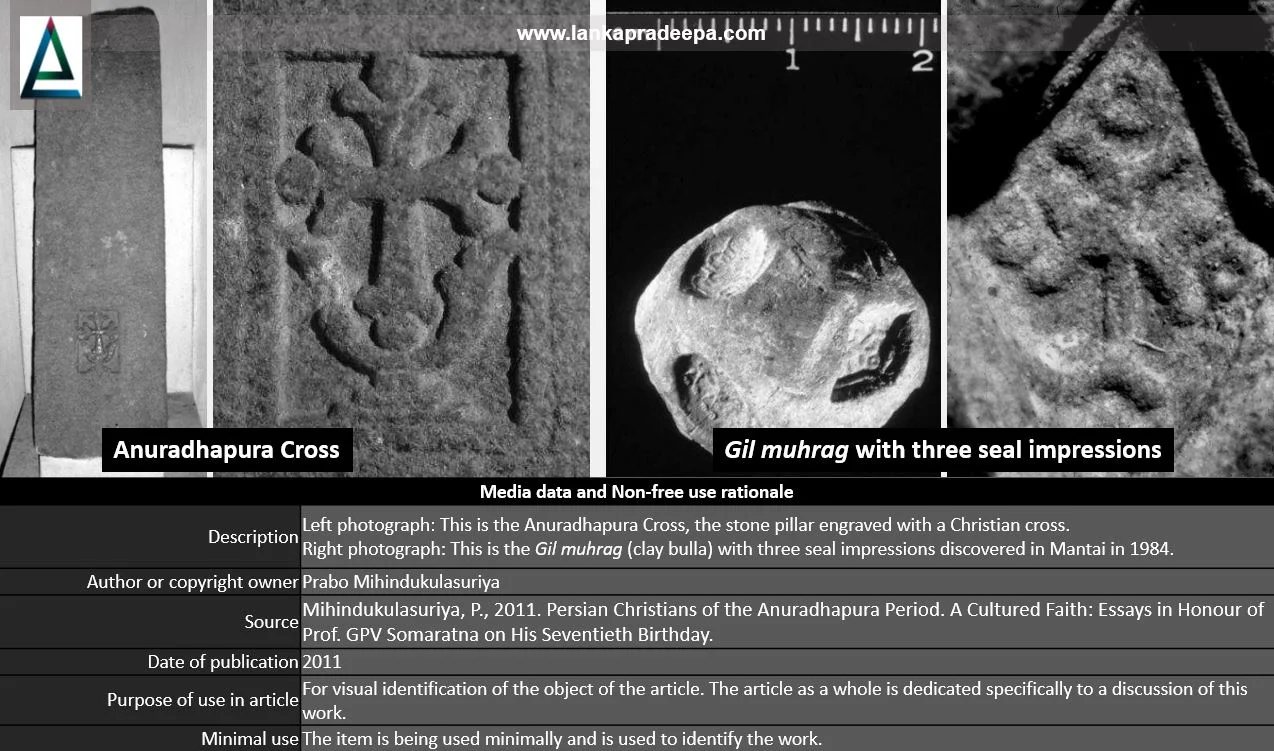
The Anuradhapura Cross (Sinhala: අනුරාධපුර කුරුසිය; Tamil: அனுராதபுரச் சிலுவை) which has been engraved on a column fragment is presently on the display at the Anuradhapura Archaeological Museum, Sri Lanka.
Discovery
The stone column with the cross symbol is said to have been found in 1912 among the Buddhist monuments in Anuradhapura Citadel or from an unknown place (Mihindukulasuriya, 2011; Wikramagamage, 2004).
Theories and opinions
Archaeological Commissioner Edward Russell Ayrton (1912-1913) presumed that the cross probably belong to some Christian building at Anuradhapura that existed during the time of the Portuguese in Sri Lanka [(1505-1658) Devendra et al, 1957; Mihindukulasuriya, 2011]. Arthur Maurice Hocart, the Archaeological Commissioner from 1922 to 1924 and from 1925 to 1927 thought that it is a Christian cross although he couldn't offer a date for it (Mihindukulasuriya, 2011). Humphrey Codrington who was a civil servant, linguist and antiquarian, assumed that it is a Nestorian Cross belonging to a community of Persian Christian who resided in Sri Lanka in about 500 A.D. (Codrington, 1994). This claim relied on the 6th-century work, "Christian Topography" which is considered the sole documentary source attesting to the presence of Persian Christians in Sri Lanka (Devendra et al, 1957). However, questioning the reliability of "Christian Topography", the then Assistant Archaeological Commissioner D.T. Devendra suggested the cross as a work of Portuguese and dated it to a time later than 1547 A.D. (Devendra et al, 1957). Devendra's opinion was dismissed by A.J.B. Antoninus while T.U. De Silva deduce the cross as a work belonged to a period later than the 11th century, at the earliest (Devendra et al, 1957).
Presence of Persian Christians in Sri Lanka
Ancient Mahatittha (present Mantai) was the main seaport of Sri Lanka during the Anuradhapura Period and archaeological evidence confirms that traders, both local and foreign, lived in the area and were engaged in indigenous and international trade (Wikramagamage, 2004). Although there is no evidence to prove that there were local Christians during early or medieval Sri Lanka, it is suggested that some of the traders at Mahatittha were Persian Christians and their representatives may have lived even in the Anuradhapura City in the 6th century A.D. (Wikramagamage, 2004). According to the view of Wikramagamage, the cross (Nestorian) depicted on stone in the Anuradhapura Museum may have been a sacred item used by them (Wikramagamage, 2004).
In 1984, archaeologist John Carswell found a Sasanian Period (224-651 A.D.) Gil muhrag (clay bulla) with three seal impressions during excavations done in Mantai (Mihindukulasuriya, 2011). Of the three seal impressions, one, set within a diamond field, is a Nestorian cross with similar stylistic features to the Cross of Anuradhapura (Bohingamuwa, 2017; Mihindukulasuriya, 2011).
Design of the cross
Studies in Syriac iconography have pointed to several recurrent stylistic elements that characterize Nestorian crosses and three of these composite motifs are identifiable in the Anuradhapura Cross (Mihindukulasuriya, 2011). They include; i) the leaved device that emerges from the base of the cross, ii) the pears at the termination of each arm of the cross and iii) the base of a three-stepped pedestal (Mihindukulasuriya, 2011).
References
1) Bohingamuwa, W., 2017. Ancient "Mahatittha" (Mantai) in Sri Lanka: A Historical Biography. Journal of the Royal Asiatic Society of Sri Lanka, pp.23-50.
2) Codrington, H.W., 1994 (first published in 1929). A short history of Ceylon. Asian Educational Services. p.32.
3) Devendra, D. T., Antoninus, A. J. B., & De Silva, T. U., 1957. The Date of the Anurādhapura Cross. The Journal of the Ceylon Branch of the Royal Asiatic Society of Great Britain & Ireland, New Series, Vol. 5, No. 1 (1957), pp. 85-96
4) Mihindukulasuriya, P., 2011. Persian Christians of the Anuradhapura Period. A Cultured Faith: Essays in Honour of Prof. GPV Somaratna on His Seventieth Birthday.
5) Wikramagamage, C., 2004. Heritage of Rajarata: Major natural, cultural, and historic sites. Colombo. Central Bank of Sri Lanka. p.82.
Location Map
This page was last updated on 14 January 2023


